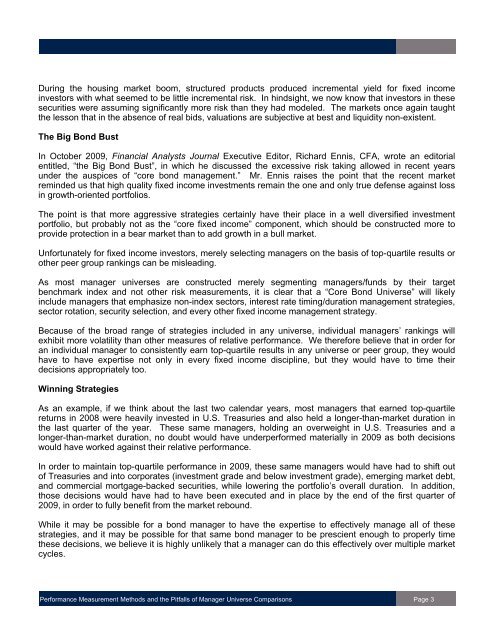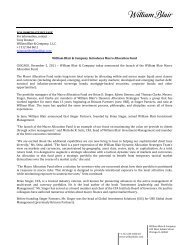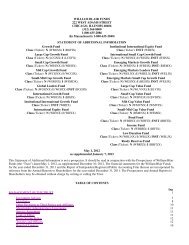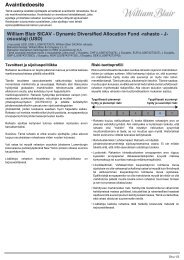Performance Measurement Methods and the Pitfalls ... - William Blair
Performance Measurement Methods and the Pitfalls ... - William Blair
Performance Measurement Methods and the Pitfalls ... - William Blair
Create successful ePaper yourself
Turn your PDF publications into a flip-book with our unique Google optimized e-Paper software.
During <strong>the</strong> housing market boom, structured products produced incremental yield for fixed income<br />
investors with what seemed to be little incremental risk. In hindsight, we now know that investors in <strong>the</strong>se<br />
securities were assuming significantly more risk than <strong>the</strong>y had modeled. The markets once again taught<br />
<strong>the</strong> lesson that in <strong>the</strong> absence of real bids, valuations are subjective at best <strong>and</strong> liquidity non-existent.<br />
The Big Bond Bust<br />
In October 2009, Financial Analysts Journal Executive Editor, Richard Ennis, CFA, wrote an editorial<br />
entitled, “<strong>the</strong> Big Bond Bust”, in which he discussed <strong>the</strong> excessive risk taking allowed in recent years<br />
under <strong>the</strong> auspices of “core bond management. ” Mr. Ennis raises <strong>the</strong> point that <strong>the</strong> recent market<br />
reminded us that high quality fixed income investments remain <strong>the</strong> one <strong>and</strong> only true defense against loss<br />
in growth-oriented portfolios.<br />
The point is that more aggressive strategies certainly have <strong>the</strong>ir place in a well diversified investment<br />
portfolio, but probably not as <strong>the</strong> “core fixed income” component, which should be constructed more to<br />
provide protection in a bear market than to add growth in a bull market.<br />
Unfortunately for fixed income investors, merely selecting managers on <strong>the</strong> basis of top-quartile results or<br />
o<strong>the</strong>r peer group rankings can be misleading.<br />
As most manager universes are constructed merely segmenting managers/funds by <strong>the</strong>ir target<br />
benchmark index <strong>and</strong> not o<strong>the</strong>r risk measurements, it is clear that a “Core Bond Universe” will likely<br />
include managers that emphasize non-index sectors, interest rate timing/duration management strategies,<br />
sector rotation, security selection, <strong>and</strong> every o<strong>the</strong>r fixed income management strategy.<br />
Because of <strong>the</strong> broad range of strategies included in any universe, individual managers’ rankings will<br />
exhibit more volatility than o<strong>the</strong>r measures of relative performance. We <strong>the</strong>refore believe that in order for<br />
an individual manager to consistently earn top-quartile results in any universe or peer group, <strong>the</strong>y would<br />
have to have expertise not only in every fixed income discipline, but <strong>the</strong>y would have to time <strong>the</strong>ir<br />
decisions appropriately too.<br />
Winning Strategies<br />
As an example, if we think about <strong>the</strong> last two calendar years, most managers that earned top-quartile<br />
returns in 2008 were heavily invested in U.S. Treasuries <strong>and</strong> also held a longer-than-market duration in<br />
<strong>the</strong> last quarter of <strong>the</strong> year. These same managers, holding an overweight in U.S. Treasuries <strong>and</strong> a<br />
longer-than-market duration, no doubt would have underperformed materially in 2009 as both decisions<br />
would have worked against <strong>the</strong>ir relative performance.<br />
In order to maintain top-quartile performance in 2009, <strong>the</strong>se same managers would have had to shift out<br />
of Treasuries <strong>and</strong> into corporates (investment grade <strong>and</strong> below investment grade), emerging market debt,<br />
<strong>and</strong> commercial mortgage-backed securities, while lowering <strong>the</strong> portfolio’s overall duration. In addition,<br />
those decisions would have had to have been executed <strong>and</strong> in place by <strong>the</strong> end of <strong>the</strong> first quarter of<br />
2009, in order to fully benefit from <strong>the</strong> market rebound.<br />
While it may be possible for a bond manager to have <strong>the</strong> expertise to effectively manage all of <strong>the</strong>se<br />
strategies, <strong>and</strong> it may be possible for that same bond manager to be prescient enough toproperly p time<br />
<strong>the</strong>se decisions, we believe it is highly unlikely that a manager can do this effectively over multiple market<br />
cycles.<br />
<strong>Performance</strong> <strong>Measurement</strong> <strong>Methods</strong> <strong>and</strong> <strong>the</strong> <strong>Pitfalls</strong> of Manager Universe Comparisons Page 3








